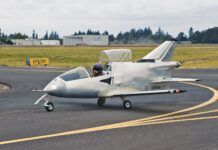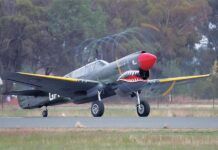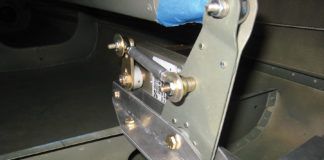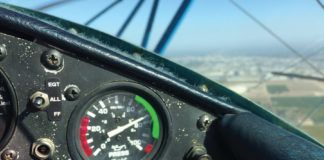Last month we introduced the concept of “size, bones, balance” and started on the initial layout of the airplane. We now turn our attention to the next step in sizing the airplane, which is to get an idea of how much it will weigh.
Known Weights
At the outset of the design, there are certain weights that are chosen as part of the requirements for the airplane.

People
The first consideration is the weight of the pilot and passengers. The airplane will be designed to be capable of carrying a certain number of people. How many depends on the mission of the airplane. The designer must choose a “typical” weight to use for each occupant of the airplane. At one time the FAA specified 170 pounds as a “standard human” for weight calculations. In modern times we know that this is too light to properly represent the U.S. population. For American males, the 50th percentile weight is just over 180 pounds, while the 75th percentile is slightly over 200. If the airplane is required to carry full-sized adults in every seat, the designer would be well advised to use a weight in this range for initial weight calculations. Note that these weights do not include clothing or personal items carried in pockets. The current FAA advisory circular used for calculating passenger weights for airlines (AC 120-27E) specifies 200 pounds for an adult male and 179 pounds for an adult female in summer and adds 5 pounds to each for winter. A general aviation designer would be well advised to use at least the summer adult male weight (200 pounds) as a typical occupant weight.
Baggage and/or Cargo
Another weight chosen at the outset is the cargo/baggage weight. Airlines use 50 pounds per person as baggage weight. If the airplane is intended more as a cargo hauler than a people transporter, then the design specification must define the weight of the cargo the airplane must carry.
Instruments and Avionics
The mission of the airplane implies a minimum suite of instruments and avionics. For preliminary design, we can choose a baseline set of equipment and use actual weights for our design estimates. As the design gets more refined, we must also then take into account the weight for mountings and wiring to power the avionics.
First Weight Estimate
Once the cabin and cargo hold or baggage compartment are defined, these components have essentially constant weight as the rest of the airplane evolves. In order to get started on sizing wing, engine, and fuel capacity, we need an initial estimate of the gross weight of the airplane.
A common method of doing this is to use statistical analysis of similar airplanes that are already flying. If we take the combined weight of the occupants and baggage, and divide it by gross weight for existing airplanes, we can determine a typical percentage of gross weight for these known items. We can then use this percentage to estimate the gross weight of our new design.
For example, suppose we are designing a new 2-seat, fixed-gear airplane. If we use the “standard” weights discussed above, we will be carrying 400 pounds of human and 100 pounds of baggage, for a total of 500 pounds. I did a quick (and by no means comprehensive) look at 2-seat fixed-gear kit airplanes and found that the “people plus baggage” as a percentage of gross weight ranged from 24% to 28% for the airplanes I surveyed. Accordingly, if I use this to get my initial weight estimate for my new airplane, the gross weight will range between:
500/0.28 =1785 pounds
And:
500/0.24 = 2083 pounds.
For an average of 1934 pounds.
Depending on how optimistic the designer is, or how well-understood the configuration and structural materials of the new design are, any one of these 3 weights might be a reasonable estimate with which to start detailed design.
One caution is in order here. The above analysis illustrates one of the most important issues in airplane design: Adding weight adds even more weight. Each additional pound arbitrarily added to the airplane carries with it a “wrap weight” that is usually greater than the initial weight increment, once all of the effects of the initial weight increment are taken into account.
Using our example airplane, suppose our passenger and pilot each want to add 5 pounds to their baggage allocation. For our average case above, that additional 10 pounds will increase the takeoff gross weight of the airplane by about 38 pounds. Carrying the 10 pounds of additional baggage will require an additional 28 pounds of airplane and fuel to fly the same mission. This wrap rate varies depending on the type of airplane and its mission, but in some cases it can exceed 5 pounds of takeoff weight for every pound of arbitrary weight added.
Fortunately for clever designers, the weight wrap rate works both ways. Every pound of fixed weight saved yields an attendant larger reduction in gross weight.
Initial Wing and Engine Sizing
Once we have our first weight estimate, we can move on to our first estimate of wing size and engine choice. In some respects, initial engine sizing is easier because the designer has only a relatively few discrete choices. Engine manufacturers make specific engines, and the designer must choose one of them. As with our initial gross weight estimate, a good first step is to look statistically at the power-to-weight ratio of existing airplanes. For the two-place airplanes I surveyed, power-to weight ratios varied from a low of 16 pounds per horsepower to a high of 12 pounds per horsepower. Accordingly, for our average-weight example airplane (1934 pounds), my initial engine choice would range between 120 and 160 hp. If the designer is a fan of Lycoming engines, this would mean a choice between an O-235 and an O-320.
Once we are in the ballpark with statistical analysis, some initial consideration of desired performance and/or cost might drive the initial determination one way or another.
Wing sizing is more complex and will be discussed in detail in a subsequent edition of “Wind Tunnel.” While it is possible to get a rough initial estimate by using a statistically derived wing loading from other airplanes, this will likely prove too crude an initial estimate to be particularly useful. Accordingly, the first bit of more detailed design that should be done after the initial layout is the preliminary design of the wing.
First Performance Estimate
At this point in the design, we have a preliminary layout of the airplane. The basic shape of the fuselage has been defined. We have chosen an engine to start with and have a first design iteration completed on the wing. The wing size will allow a preliminary estimate of the size of the tail surfaces to be made. With that done, we have enough information to make a more refined weight estimate and then generate an initial estimate of the drag and performance of the airplane.
Iterate, Iterate, Iterate
With the first performance calculations in hand, the designer can compare the performance of the initial design to the design requirements. Inevitably, the first cut at the design will not meet the performance specifications exactly.
For each design cycle, the designer will make changes to the airplane to bring its performance in line with the design requirements. Note that this does not always mean that the initial design falls short of requirements. It’s entirely possible to find out that you have overshot the requirement, and your initial concept has more range or more speed than required. While this might seem, at first blush, to be a good thing, it also means that the initial design is larger, heavier, and more expensive than an optimized design that just meets the design requirements. Since cost is also a “performance parameter,” this is where it falls short.
After making changes, we repeat the weight estimation and performance calculations. Because each change affects multiple variables, the performance may change more than our initial estimate.
Assuming that the requirements are meetable, and the changes to the design are in the right direction, each cycle brings the design closer to the design requirements. (This is not always the case. It’s possible to get in a situation where a design will not be close, and each iteration leads to the airplane getting worse, not better. If this is happening, either the requirements are not realistic, or some element of the design approach is not suitable to the mission.)
After several cycles, the calculated performance of the airplane will be close enough to the design requirements to be acceptable. At this point, it’s time to move into detail design and start thinking about building it.















Quote from under the photo above . : ” Back in the day, the FAA specified 170 pounds as the weight of a “standard human” for weight calculations. These days, they use 200 pounds for an adult male and 179 pounds for an adult female in summer, plus an additional 5 pounds for each in winter. ”
This makes a lot of sense to me . Back in 1970 in my flight home from Korea , I , like all the rest , were placed on a DC=8 ‘ ‘Stretch ‘ military charter airliner , There was no first class , or business class seating . Just one long tube with seating from front to rear. Almost all male except for stewardesses . We had a very very fast take-off and a very very fast landing in Japan . We lost wheels . I saw one of them slowing down in the grass at about the same rate of deceleration that we were doing . We had three huge bounces up into the aire after the initial bounce while the pilot was tryng to get the plane to stay on the ground . And then finally , we ran off the far end of the runway into the grass at the end . We were pulled out and towed to the terminal ( Yacoda Air Base , Japan ) . After we got into the termanal there was an annnouncement that our flight would be delayed . I watched as they installed a wheel using a huge jack that looked just like a car jack but much bigger . Later , aftere a few drinks , we all got back into that same plane and had another very high speed take-off and when getting ready to land , we were all very concerned and had another very high speed landing . That plane must have been heavy . .
So, i think it’s a very good rule of thumb to assume a higher substantial amount of weight per person . Better safe than sorry . BTW, that was the smoothest flight i was ever on .
PS. I think assuming only 200 lbs per male passenger is not enough . Should be around 250 .